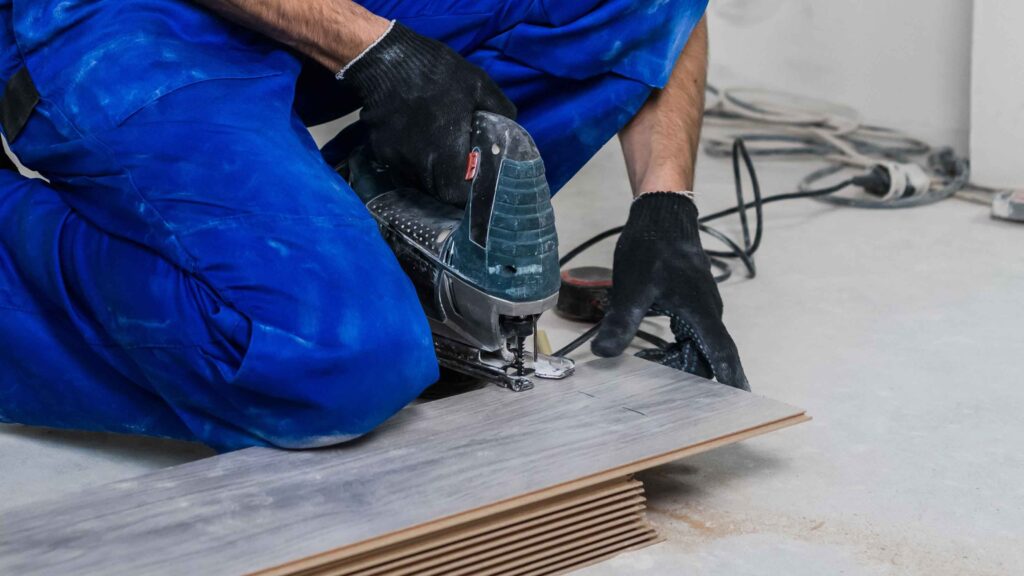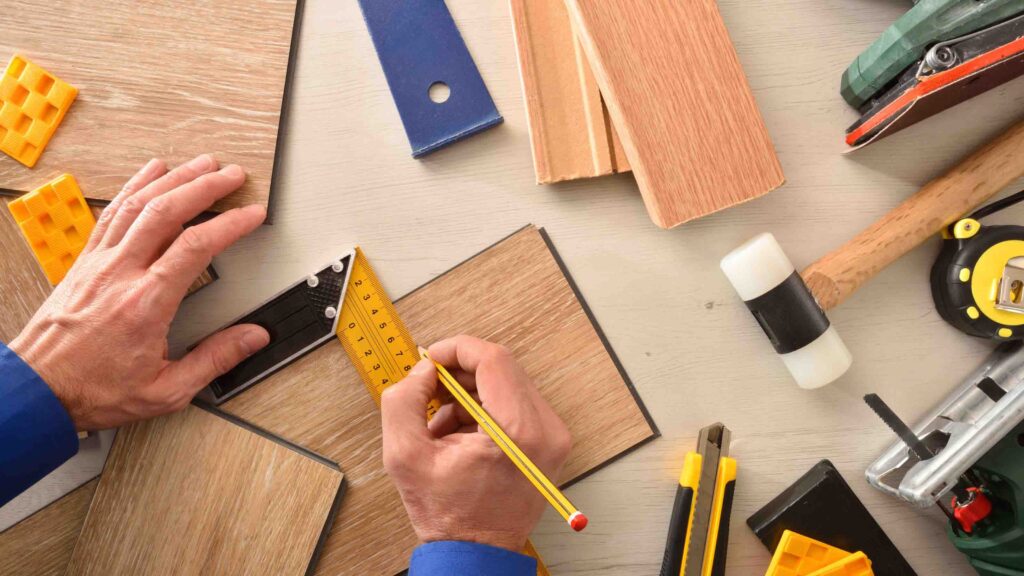Laminate flooring has become one of the most popular choices for homeowners and DIY enthusiasts due to its durability, affordability, and stylish appearance. But one question often stands between a successful installation and frustration: What exactly should you use to cut laminate flooring? This seemingly simple question can impact the entire project’s quality and timeline.
In short, the best tools to cut laminate flooring include specialized laminate cutters, power saws with carbide-tipped blades, and even manual handsaws, depending on the cut type and user experience. Safety, precision, and the right blade type are essential to avoid damaging the flooring or creating uneven edges.
Imagine you’re halfway through your flooring project, ready to cut your last plank, only to realize your tools are wrong — chips, splinters, and wasted materials start piling up. Sound familiar? Stick with me as we explore the best tools, techniques, and insider tips to make cutting laminate flooring a breeze.
1. What Tools Are Commonly Used to Cut Laminate Flooring?

Common tools to cut laminate flooring include laminate cutters, circular saws, jigsaws, miter saws, and handsaws, each suited to different cutting needs and skill levels.
Tools Overview and Comparison
Laminate Cutters: The DIY Favorite
Laminate cutters are manual tools designed specifically to snap laminate planks cleanly. They’re quiet, dust-free, and perfect for straight cuts but struggle with angles or curves. Great for beginners but limited in versatility.
Circular Saws: Power and Precision
Circular saws fitted with carbide-tipped blades are excellent for long, straight cuts. They allow fast, clean cuts but require experience to handle safely. Ideal for large projects where speed and precision matter.
Jigsaws: Versatility for Curves
Jigsaws excel in cutting curves, corners, and irregular shapes that circular saws can’t handle. However, they may produce rougher edges that need sanding. Best for intricate cuts around vents or doorways.
Miter Saws: Perfect for Angled Cuts
Miter saws are precise tools used for angled or bevel cuts. While more expensive, they offer professional results on corners and trim pieces. Ideal for advanced DIYers and pros.
Handsaws: Manual Control
Traditional handsaws can cut laminate but require patience and skill to avoid chipping. Useful when power tools aren’t available but slower and less precise.
| Tool Type | Description | Best Use Case | Pros | Cons |
|---|---|---|---|---|
| Laminate Cutter | Manual tool that snaps laminate planks cleanly. | Straight cuts, beginner projects | Quiet, dust-free, easy to use | Cannot cut angles or curves |
| Circular Saw | Power saw with carbide-tipped blade for long, straight cuts. | Large projects, fast cutting | Fast, precise cuts | Requires experience, creates dust |
| Jigsaw | Power tool for cutting curves, corners, and irregular shapes. | Curved and intricate cuts | Versatile, handles curves | Rougher edges, may need sanding |
| Miter Saw | Precision saw for angled or bevel cuts. | Angled cuts, corners, trim work | Professional results, accurate | More expensive, less portable |
| Handsaw | Traditional manual saw for cutting laminate. | Small jobs, no power available | Inexpensive, manual control | Slow, requires skill, risk of chipping |
2. Which Cutting Tool Is Best for Different Types of Cuts?

The best cutting tool depends on the cut: circular saws for straight cuts, jigsaws for curves, miter saws for angles, and laminate cutters for quick snaps.
Matching Tools to Cut Types
Straight Cuts: Efficiency and Clean Lines
For straight, long cuts, circular saws or laminate cutters are top choices. Circular saws provide speed and clean edges but create dust. Laminate cutters are dust-free but slower.
Angled and Beveled Cuts: Precision Required
Miter saws shine here with adjustable angles and smooth cuts, essential for corners and molding. Circular saws can also make bevel cuts but require adjustments and skill.
Curved and Irregular Cuts: Flexibility Matters
Jigsaws allow freehand cuts around vents, pipes, or door frames. Their blade variety suits different materials but watch for splintering. Sanding edges after cutting is often necessary.
Snap Cuts: Quick and Clean for Simple Jobs
Laminate cutters work by applying pressure to snap planks cleanly. They’re best when cuts are straightforward and repeated, but don’t handle curves or angles.
| Cut Type | Recommended Tool | Key Features | Notes |
|---|---|---|---|
| Straight Cuts | Circular Saw / Cutter | Circular saw is fast and precise; cutter is dust-free and quiet | Circular saw creates dust; cutter slower |
| Angled/Beveled Cuts | Miter Saw | Adjustable angles, smooth and precise cuts | Circular saw can do bevels but needs skill |
| Curved/Irregular Cuts | Jigsaw | Handles curves and irregular shapes well | May cause splintering; sanding often needed |
| Snap Cuts | Laminate Cutter | Applies pressure to snap planks cleanly | Best for simple, straight, repeated cuts; no curves or angles |
3. How Do You Safely Cut Laminate Flooring Without Damaging It?

Safety and precision come from using the right blade, securing planks properly, wearing protective gear, and cutting slowly to prevent splintering or chipping.
Safety and Best Practices
Choose the Right Blade
Carbide-tipped blades with fine teeth minimize chipping. Blades designed specifically for laminate or hardwood produce the best edges.
Secure Your Workpiece
Use clamps or a stable cutting table to prevent movement. Unstable planks increase risk of injury and damage.
Use Protective Gear
Wear safety glasses, dust masks, and ear protection. Laminate dust can be harmful, and power tools are loud and potentially dangerous.
Cut Slowly and Steadily
Rushing can cause chips and uneven edges. Let the tool do the work and avoid forcing the cut.
Prepare Edges for Finish
Use sanding blocks or files to smooth edges, especially with jigsaw or handsaw cuts.
| Safety Practice | Description | Why It Matters |
|---|---|---|
| Choose the Right Blade | Use carbide-tipped blades with fine teeth designed for laminate | Minimizes chipping, produces clean edges |
| Secure Your Workpiece | Clamp planks or use a stable cutting surface | Prevents movement that causes injury or damage |
| Use Protective Gear | Wear safety glasses, dust masks, and ear protection | Protects eyes, lungs, and hearing from dust and noise |
| Cut Slowly and Steadily | Avoid rushing; let the tool do the work | Prevents splintering and uneven cuts |
| Prepare Edges for Finish | Sand or file edges after cutting, especially with jigsaws or handsaws | Smooths rough edges for a polished finish |
4. Do You Need Special Blades or Accessories to Cut Laminate Flooring?

Yes, carbide-tipped blades with fine teeth and accessories like clamps and cutting guides improve cut quality and precision.
Blade Types and Accessories
Carbide-Tipped vs Standard Blades
Carbide blades last longer and cut cleaner, reducing splintering on laminate’s tough surface. Standard blades wear quickly and can cause rough edges.
Tooth Count and Blade Design
Higher tooth counts create smoother cuts but slow cutting speed. A balance is key—usually 60 to 80 teeth for laminate.
Clamps and Cutting Guides
Clamps keep planks steady; guides ensure straight cuts. Both are inexpensive investments that greatly improve results.
Dust Collection Attachments
Many power saws support dust bags or vacuum hookups, keeping your workspace cleaner and safer.
| Blade or Accessory | Description | Benefit |
|---|---|---|
| Carbide-Tipped Blades | Durable blades designed for laminate with fine teeth | Last longer, cleaner cuts, less splintering |
| Standard Blades | Regular blades that wear faster | Can cause rough edges and faster dulling |
| Tooth Count (60-80 Teeth) | Higher tooth counts produce smoother cuts | Balanced speed and finish quality |
| Clamps | Secure laminate planks during cutting | Prevents movement, improves accuracy |
| Cutting Guides | Tools or jigs to guide saw for straight lines | Ensures precise, straight cuts |
| Dust Collection Attachments | Bags or vacuum systems connected to saws | Keeps workspace clean and safer |
5. Is It Possible to Cut Laminate Flooring Without Power Tools?

Manual laminate cutters and handsaws allow cutting without power tools but are slower and best for simple straight cuts.
Manual Cutting Options
Laminate Cutters: Clean and Quiet
These handheld tools work by snapping planks. No electricity needed, no dust created, but they’re limited to straight cuts.
Handsaws: Traditional but Tricky
Handsaws can cut laminate but require steady hands to avoid splinters. Best for small jobs or tight spots without electricity.
Utility Knives and Scoring Methods
Some installers score laminate deeply with a utility knife then snap it, especially for thin planks or engineered flooring. This method needs skill and patience.
Trade-Offs: Speed vs Convenience
Manual tools prioritize convenience and lower cost but sacrifice speed and versatility compared to power tools.
| Manual Cutting Method | Description | Advantages | Limitations |
|---|---|---|---|
| Laminate Cutters | Handheld tools that snap planks cleanly | Clean, quiet, no dust | Limited to straight cuts |
| Handsaws | Traditional manual saws for cutting laminate | Inexpensive, no power required | Requires skill; risk of splinters |
| Utility Knives & Scoring | Scoring laminate deeply then snapping it | Useful for thin or engineered planks | Needs patience and precision |
| Trade-Offs | Manual cutting is slower but more convenient and low-cost | No electricity needed | Less versatile and slower than power tools |
6. Are There Innovative or New Technologies for Cutting Laminate Flooring?

Laser-guided saws, oscillating multi-tools, and advanced blade coatings offer improved precision, safety, and efficiency in modern laminate flooring cutting.
Innovations in Cutting Technology
Laser Guides for Accuracy
Laser guides project cut lines, reducing guesswork and improving straightness, especially useful for beginners.
Oscillating Multi-Tools
These versatile tools handle detailed cuts, curves, and sanding in tight spaces, offering multi-functionality in one device.
Advanced Blade Coatings
Coatings reduce friction and heat buildup, extending blade life and improving cut smoothness.
Smart Sensors and Safety Features
Some saws now include sensors that stop blades instantly on contact with skin, enhancing safety for DIY users.
| Innovation | Description | Benefits |
|---|---|---|
| Laser Guides | Project precise cut lines to guide saws | Improves accuracy, reduces errors |
| Oscillating Multi-Tools | Multi-function tools for detailed cuts, curves, and sanding | Versatile for tight spaces |
| Advanced Blade Coatings | Special coatings that reduce friction and heat buildup | Longer blade life, smoother cuts |
| Smart Sensors & Safety | Sensors that stop blades instantly upon skin contact | Enhanced safety for DIY users |
Sustainability in Tools
Energy-efficient tools and dust capture systems align with eco-friendly flooring installation trends.
Summary Table: Recommended Tools for Cutting Laminate Flooring
| Cutting Type | Recommended Tool | Blade Type/Accessory | Best For |
|---|---|---|---|
| Straight Cuts | Circular Saw | Carbide-tipped, 60-80 teeth | Speed, clean edges |
| Straight Cuts | Laminate Cutter | N/A | Quiet, dust-free, simple cuts |
| Angled/Bevel Cuts | Miter Saw | Carbide-tipped | Precision angles and corners |
| Curved/Irregular Cuts | Jigsaw | Fine-toothed blades | Curves, vents, irregular shapes |
| Manual Cuts | Handsaw/Laminate Cutter | N/A | Small jobs without power tools |
Ready to Upgrade Your Laminate Flooring Cutting Process?
At Kinwin, we specialize in high-quality, customizable laminate flooring and installation tools tailored to your unique needs. Whether you’re a contractor or DIY enthusiast, our products combine precision engineering with durability and sustainability. Contact us today for personalized solutions and elevate your flooring projects with confidence and ease!


